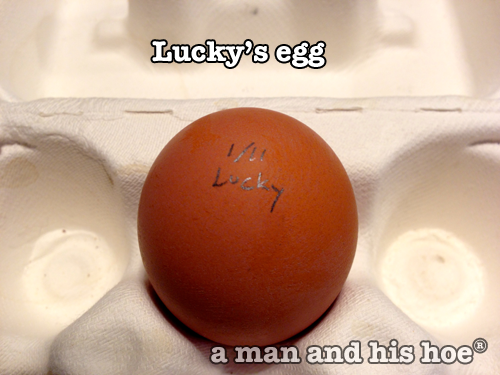The gang of 5 chicks born March 25 are nearly a month old and spending more time away from their mother. This afternoon I found them resting together, their mother happily feeding by herself.
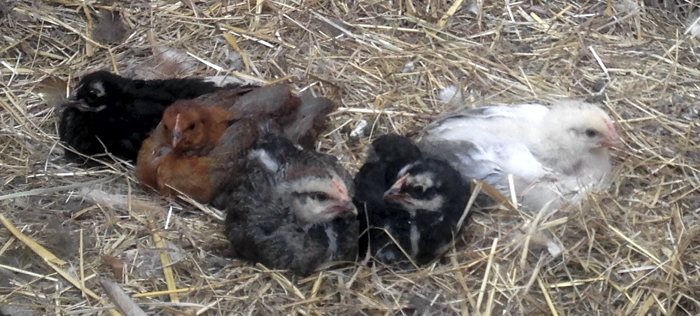
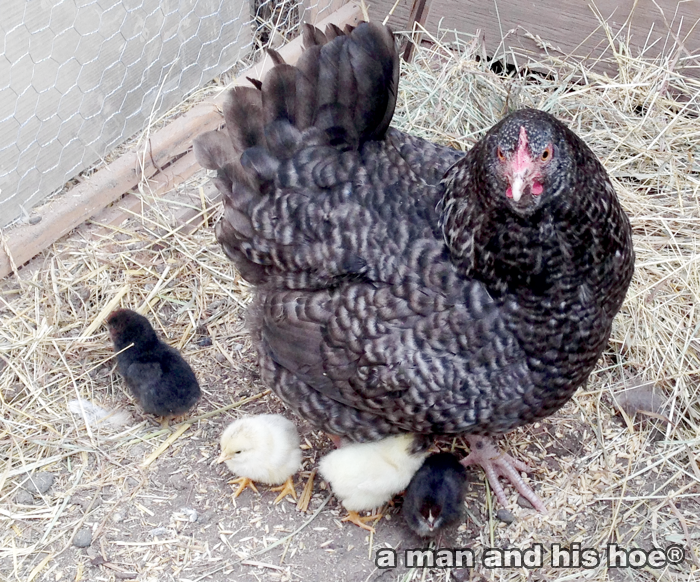
While these one day chicks, born on Easter, are getting their first taste of life outside the nest. They have a very feisty mother. In fact the most protective hen I’ve seen. It will be interesting what sort of mother she turns out to be. The variety of personalities even among hens is remarkable. Here at a man and his hoe®, the chickens have the space and freedom to let their personalities bloom.
First Post Child Rearing Egg
Hens lay special eggs at times. There is the very first egg they lay, which is a tiny egg. There is the first egg they lay after their winter lull. These eggs also tend to be smaller. And then there is the first egg they lay after raising chicks. And today this mother laid her first egg after raising chicks for three weeks. That is on the early side. Most hens take more than a month before they go back to laying eggs.
I get the sense that this mother may not be raising her chicks much longer. They are getting very independent and at times during the day they stray tens of feet from her. When she was up on the nest laying her egg, her five chicks huddled together and waited patiently for her to come back down.

Liquid Gold
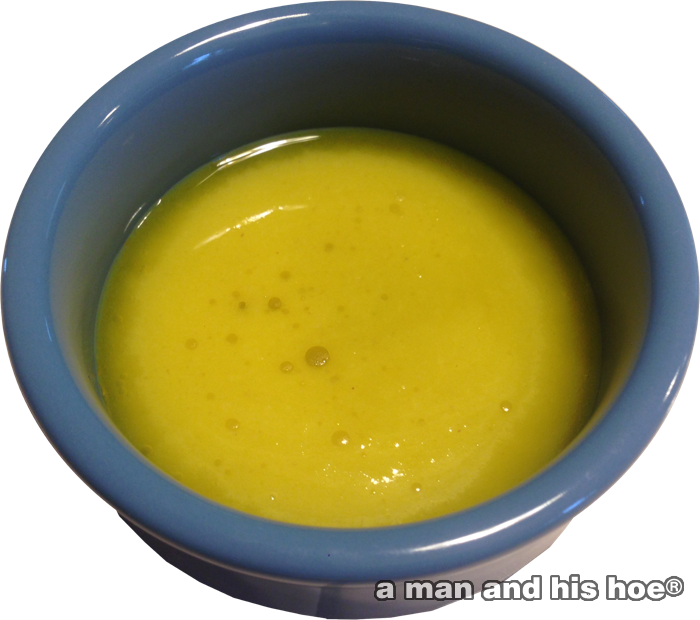
A remarkable feature of the chickens from a man and his hoe® is the golden fat on the birds. It’s more like oil or butter than the fat you find on beef and pork. At room temperature it is liquid and makes a delicious fat for frying.
Dirt Bath
On a bright sunny day, chickens enjoy having a bath in the warm dirt. They can spend an entire hour rolling around in the dirt, and often they like to do this in small groups. This is behavior that is innate and something they seem to need to do, like pigs needing to wallow in mud.
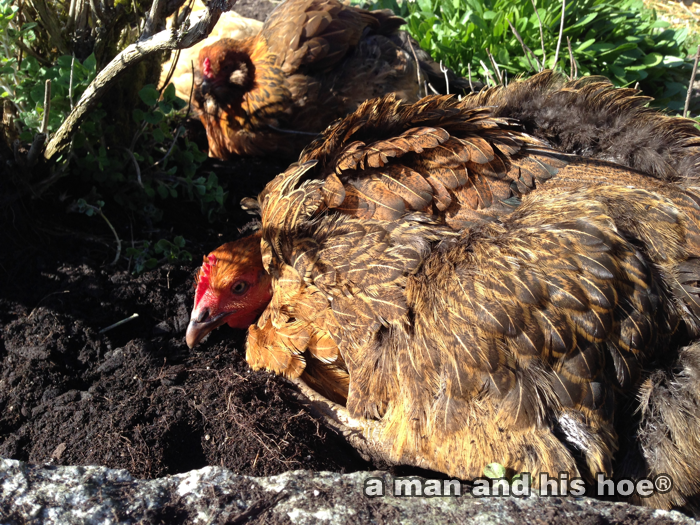
So how do birds in these cage-free “humanely-raised” egg laying operations get to roll around in the dirt in the bright sunshine and fresh air? The next time you buy eggs, ask the grocer if the hens who laid the eggs you are buying, get to spend hours rolling around in the dirt in the afternoon sun.

[wpvideo 4WdMujB4]
Working Mother To Be
So what is life like for a mother-to-be hen? Most of the time, day and night, it is sitting quietly on her eggs. She is also gently turning the eggs many times a day. This keeps the embryo centered in the egg and prevents it from sticking to the shell membrane. She also protects the eggs she is sitting on and will keep other hens and predators from getting into her nest. (The squiggly lines on the eggs are ones I drew to mark the eggs she started incubating.)
 Of course, a hen doesn’t have a servant to bring her food and water. At least once a day, she has to leave the nest to eat, drink, go to the bathroom, and get some exercise.
Of course, a hen doesn’t have a servant to bring her food and water. At least once a day, she has to leave the nest to eat, drink, go to the bathroom, and get some exercise.
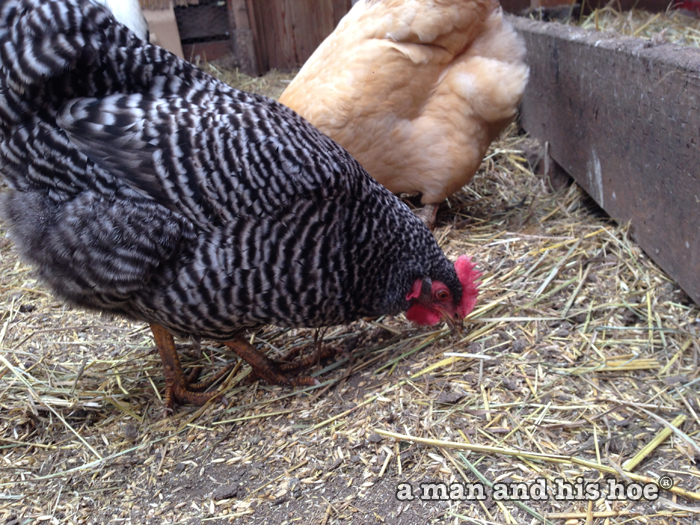 Afterwards, she is back on her nest until the next day.
Afterwards, she is back on her nest until the next day.
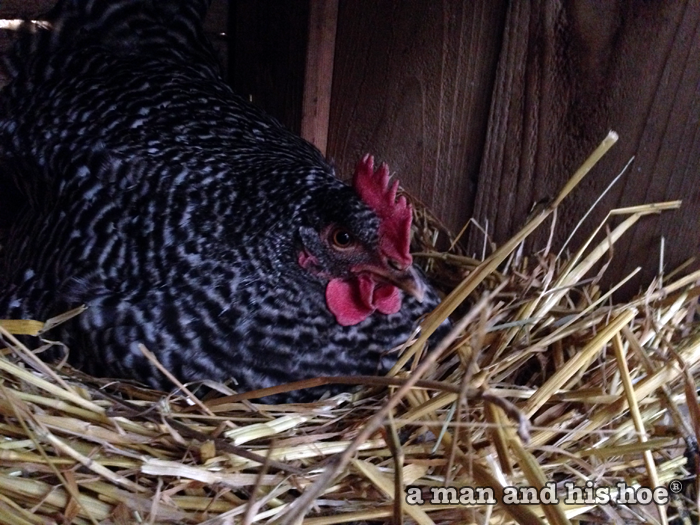
Japanese Chicken Varieties
The lack of varieties of chickens sold in supermarkets in the US is rather surprising. Some stores make distinctions between organic versus conventional, pastured versus broiler chickens, but rarely do you see a selection of a variety of chicken breeds on sale. The main distinction which is mostly emphasized is which chicken is the cheapest.
But, take a look at the way chicken is marketed and sold in Japan, and there is an astonishing variety of chicken breeds for sale. Here are just ten of these varieties.
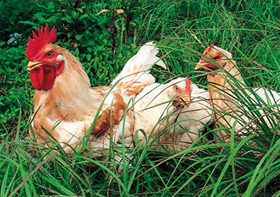
Banshu Hyakunichi Tori is a pasture raised variety of White Cornish from Hyogo Prefecture.
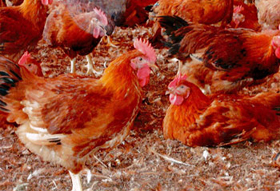
Bungo Akadori is a Red Cornish and Rhode Island Red cross from Oita Prefecture in southern Japan.
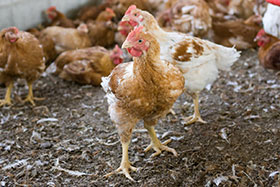
Fumoto Dori is a red chicken from Saga Pefecture in southern Japan.
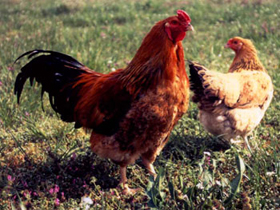
Hogo Aji Dori, which translates to Flavorful Chicken from Hyogo, is a cross between Satsuma and Nagoya varieties of chickens.
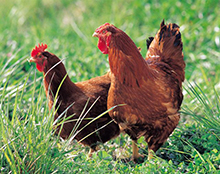
Mikawa Akadori is a cross between a Heavy Rhode Island and Rhode Island Red chicken from Aichi Prefecture in central Japan. It is a pastured chicken.
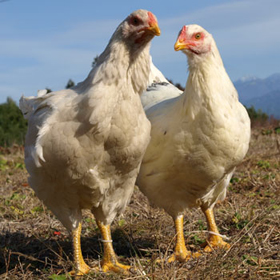
Minami Shinshu Jidori is a pastured chicken from Nagano Prefecture in central Japan. It is known for its firm, tasty, juicy meat. Only a hundred of these chickens are produced a month.

Mitsuse Tori is a variety of chicken based on French breeds. It is raised in Saga Prefecture in southern Japan.
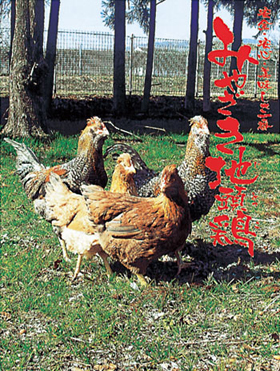
Miyazaki Jidokko is a chicken from Miyazki Prefecture in southern Japan. It is noted for not having the smell chicken meat has, having good texture and being very tasty.
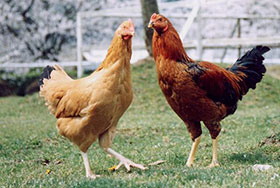
Yamato Niku Dori is a pastured chicken from Nara Prefecture. It is known for keeping its shape even when stewed for a long time, and for its rich, sweet juices. Some 8,000 of them are produced each month.

Yasato Honaji Dori is from Ibaraki Prefecture in northern Japan. It is a pastured chicken, fed non-GMO feed, never given antibiotics or medications, and is fed the bacterial culture used to create a type of fermented bean. Supposedly this culture controls salmonella and e. coli 0-157.
These are just a few of the many varieties of chickens raised in Japan. Even though pages on this link are all in Japanese, Guide to Japanese Chickens, browsing through them you can get an idea of the great variety of chickens raised in Japan for the market.
Nest at the Top of a Stump

Chickens are always looking for great places to build a nest. Yesterday I heard a white Bresse cackling by the side of a ten foot tall stump. I climbed up to the top and found a nest with eight eggs. Just one of the eggs was hers, the white egg. The mystery to uncover is what other hen has been laying eggs up there.
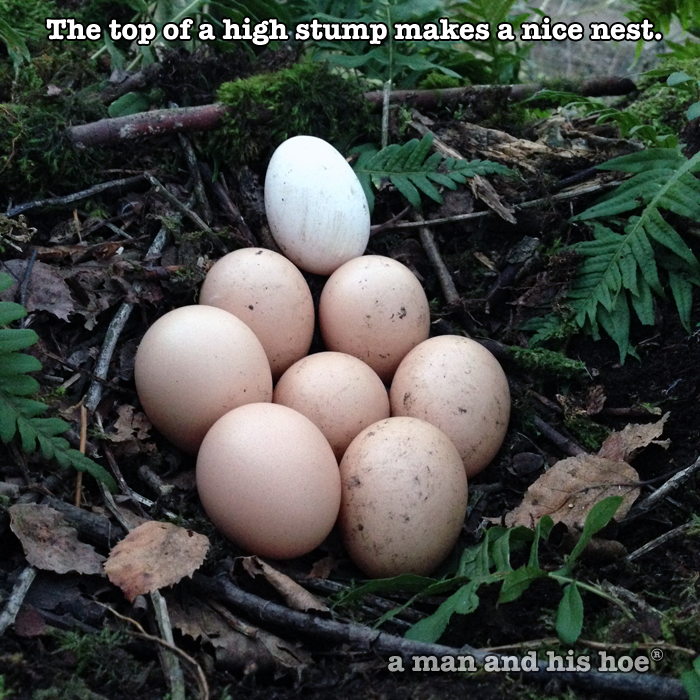
Hazel’s Egg
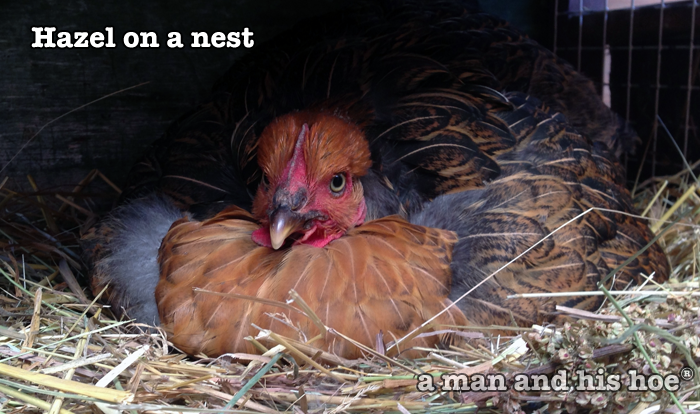
Every hen lays a special egg. To lay wonderful eggs, chickens need good food, plenty of exercise, and a quiet place to sit.
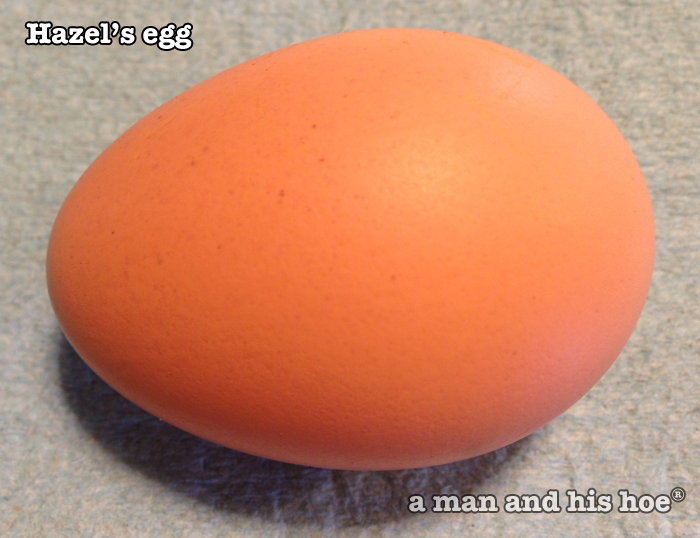
Strike a Pose
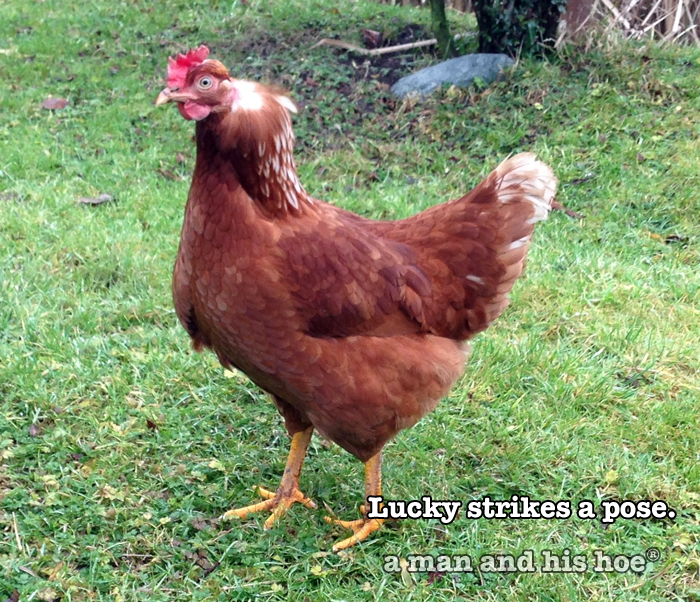
Every chicken at a man and his hoe® has a story. Lucky had an unfortunate accident as a chick. Somehow she scraped the back of her head and for several weeks had to be separated from her siblings and mother while her wound healed. We kept her in a wire cage next to her siblings so she wouldn’t feel isolated. Even so, it was not an easy time for her as she so wanted to be running around with them. Unfortunately, chicks can’t help but peck when they see blood, and if we had let her run with her siblings, she would have met with an unfortunate demise.
Once her wound healed, we were able to set her free. Now she cuts an imposing figure, and has a habit of laying her egg in one of the dog houses. If we don’t fetch her egg quickly enough, the dogs get a tasty snack. We just have to keep our ears attuned to her “I’ve hatched an egg” cackle between seven and eight in the morning to fetch the eggs before the dogs get it.
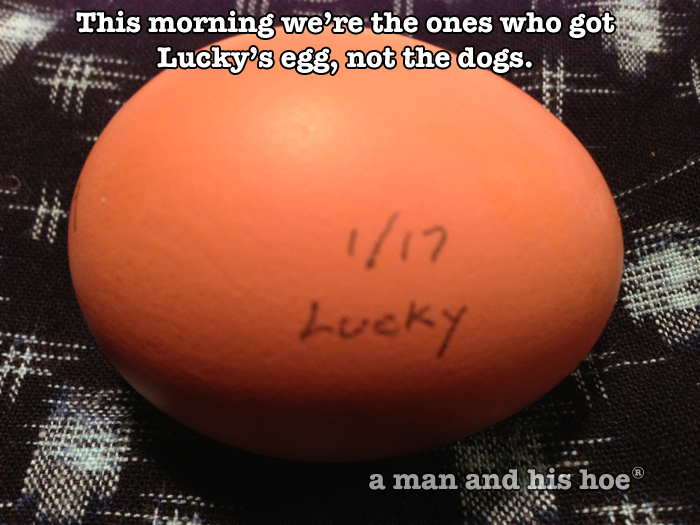
Morning Eggs
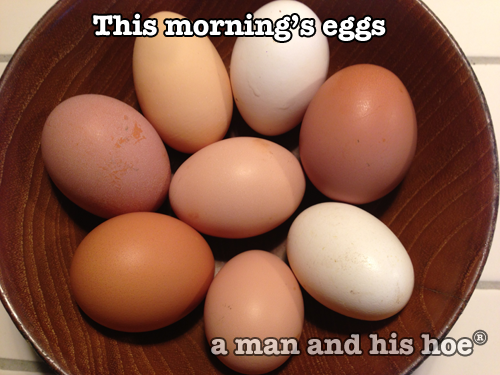
Even though it is still early January, the hens are laying more eggs. Their winter slump has ended and daily egg production has gone from five to seven up to eighteen. It will double from that in a few months.
We have one hen, Lucky, who lays her eggs in one of the dog houses. Each morning it is a race between us and the dogs as to who gets her eggs. This morning we got the egg. Most mornings all we find is an empty shell.
